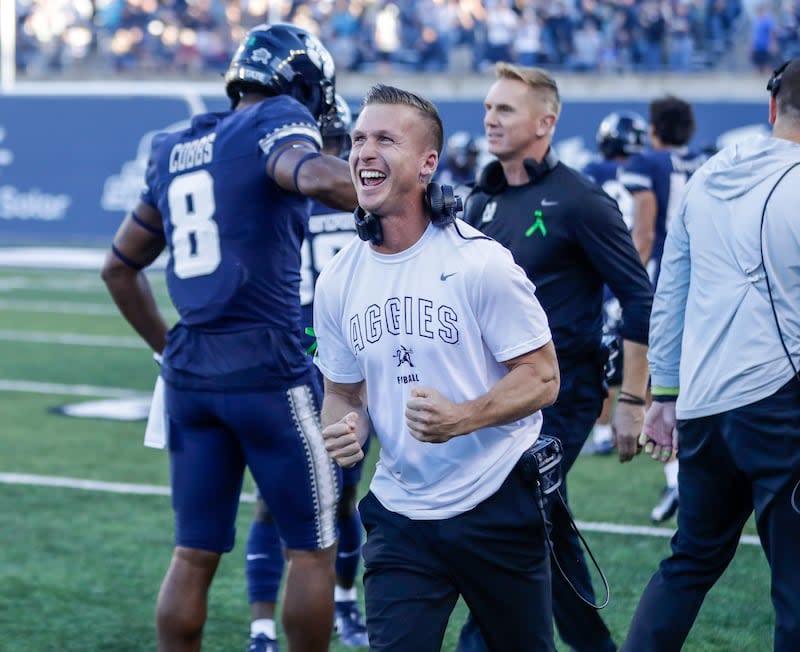
For nearly a month now, football has been an afterthought in conversations regarding Utah State.
Sure, when the news first broke that USU intended to fire Blake Anderson as the program’s head coach, there were briefly discussions about which Aggie players might leave — per NCAA rules, players have 30 days to enter the transfer portal following a head coach’s departure — and enter the transfer portal.
There were also a couple of days where it seemed as though safety Ike Larsen would leave the program and ultimately wide receivers Zakkarii Black and Micah Davis did.
But by and large, conversations about Utah State football have centered on Anderson’s dismissal, as well as that of deputy athletic director Jerry Bovee, associate athletic director Amy Crosbie, and director of player development and community engagement Austin Albrecht.
That all is about to change.
Fall camp for Utah State begins Thursday, and a month from now USU will kick off the 2024 season with a game at home against Robert Morris.
Given all the off-the-field turmoil, there are plenty of questions about this Aggies team.
Here are some of the most notable.
Are the right coaches in place?


With the departure of Anderson, Utah State’s coaching staff has changed. Not significantly in terms of new coaches, though there are a few of those. No, the most significant changes have come via increased responsibilities.
USU announced that offensive coordinator Kyle Cefalo will be the team’s offensive play-caller this season — in 2023 Anderson performed that duty — in addition to serving as the wide receivers coach. It will be the first time in Cefalo’s career that he will call plays.
There’s more though.
Offensive line coach Cooper Bassett is now a co-offensive coordinator. The closest he’s come to that in his coaching career was when he was the run-game coordinator/offensive line coach at West Texas A&M.
Hayden Kingston, formerly an offensive analyst, is now USU’s quarterbacks coach, tasked with leading a room that is filled with newcomers to USU in Spencer Petras, Jacob Conover and Bryson Barnes, as well as the talented but unproven CJ Tiller.
On defense, Bobby McMillen, a USU coach as of February, will be the co-defensive coordinator, along with interim head coach Nate Dreiling.
Then there are the new additions, as of last week, Troy Morrell and Dave Wiemers. Morrell will be the team’s associate head coach and a senior offensive analyst, while Wiemers will be a senior defensive analyst.
Even though Anderson was the only coach to leave USU’s coaching staff, the group looks little like it did last season with new faces and new responsibilities aplenty.
And that is before you mention that Dreiling is now a first-time head coach at only 33 years old.
Are the coaches up to the task of leading Utah State through significant tumult? They’ve done so already for nearly a month, but the saga surrounding the termination of Anderson isn’t going anywhere anytime soon.
Can the Aggies’ coaching staff actually help propel USU forward in 2024 rather than just tread water for the season? USU is coming off back-to-back 6-7 seasons and had one of the worst defenses in all of the FBS last season. Improvement is needed.
Dreiling has his supporters, chief among them being athletic director Diana Sabau.
“We are blessed to have Nate Dreiling,” Sabau told the Deseret News. “Nate is a head coach. He has all the tools and he is ready to go. When he came to us from New Mexico State in January he was embraced quickly by our team.”
Dreiling has to win over the entire team, though, and he knows it.
“The hard part about this job with where we were at, I’ve been around the defensive guys so much,” Dreiling said at Mountain West Conference media days. “Now I have to get these offensive guys to believe in me as well if this is going to be successful.”
Did Utah State address its biggest weakness enough?


Over the course of the 2023 season, a general theme emerged about the Aggies. In losses to Air Force, San Jose State and Boise State it was most pronounced, namely that the Aggies were small where it matters most — in the trenches.
USU has never had the biggest offensive and defensive lines, but Anderson talked numerous times last season about the need for USU’s O-line and D-line to get bigger and stronger. To do that, he said over and over, was going to require some additions to the program.
By most metrics, Utah State succeeded in bolstering both of its lines during the offseason.
On the O-line, the Aggies welcomed notable transfers in Trey Andersen and George Maile, both of whom were contributors at power conference programs, Andersen at Pitt and Maile and Baylor.
And on the D-line, USU has been almost completely remade. The Aggies adding Macyo Williams from Kent State, Gabriel Iniguez Jr. from New Mexico State, Ricky Lolohea from Oklahoma State, Miguel Jackson from Charlotte via the transfer portal…
Deseret News







